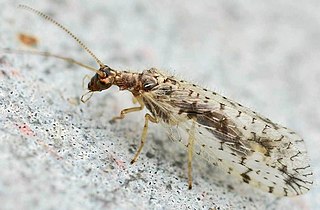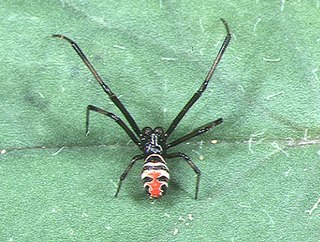
Caenorhabditis elegans is a free-living transparent nematode about 1 mm in length that lives in temperate soil environments. It is the type species of its genus. The name is a blend of the Greek caeno- (recent), rhabditis (rod-like) and Latin elegans (elegant). In 1900, Maupas initially named it Rhabditides elegans. Osche placed it in the subgenus Caenorhabditis in 1952, and in 1955, Dougherty raised Caenorhabditis to the status of genus.

Nepal, officially the Federal Democratic Republic of Nepal, is a landlocked country in South Asia. It is mainly situated in the Himalayas, but also includes parts of the Indo-Gangetic Plain. It borders the Tibet Autonomous Region of China to the north, and India in the south, east, and west, while it is narrowly separated from Bangladesh by the Siliguri Corridor, and from Bhutan by the Indian state of Sikkim. Nepal has a diverse geography, including fertile plains, subalpine forested hills, and eight of the world's ten tallest mountains, including Mount Everest, the highest point on Earth. Kathmandu is the nation's capital and the largest city. Nepal is a multi-ethnic, multi-lingual, multi-religious and multi-cultural state, with Nepali as the official language.

The insect order Neuroptera, or net-winged insects, includes the lacewings, mantidflies, antlions, and their relatives. The order consists of some 6,000 species. Neuroptera is grouped together with the Megaloptera and Raphidioptera (snakeflies) in the unranked taxon Neuropterida.

Green lacewings are insects in the large family Chrysopidae of the order Neuroptera. There are about 85 genera and 1,300–2,000 species in this widespread group. Members of the genera Chrysopa and Chrysoperla are very common in North America and Europe; they are very similar and many of their species have been moved from one genus to the other time and again, and in the nonscientific literature assignment to Chrysopa and Chrysoperla can rarely be relied upon. Since they are the most familiar neuropterans to many people, they are often simply called "lacewings". Since most of the diversity of Neuroptera are properly referred to as some sort of "lacewing", common lacewings is preferable.

Megaloptera is an order of insects. It contains the alderflies, dobsonflies and fishflies, and there are about 300 known species.

Hemerobiidae is a family of Neuropteran insects commonly known as brown lacewings, comprising about 500 species in 28 genera. Most are yellow to dark brown, but some species are green. They are small; most have forewings 4–10 mm long. These insects differ from the somewhat similar Chrysopidae not only by the usual coloring but also by the wing venation: hemerobiids differ from chrysopids in having numerous long veins and forked costal cross veins. Some genera are widespread, but most are restricted to a single biogeographical realm. Some species have reduced wings to the degree that they are flightless. Imagines (adults) of subfamily Drepanepteryginae mimic dead leaves. Hemerobiid larvae are usually less hairy than chrysopid larvae.

The Neuropterida are a clade, sometimes placed at superorder level, of holometabolous insects with over 5,700 described species, containing the orders Neuroptera, Megaloptera, and Raphidioptera (snakeflies).

The spotted giant flying squirrel, also known as the lesser giant flying squirrel, is a species of rodent in the family Sciuridae. It is found in hill and mountain forests at altitudes of 200–4,000 m (660–13,120 ft) in Southeast Asia north to central China and the east Himalayan region, although the northern populations sometimes are regarded as separate species as the grey-headed giant flying squirrel, Chindwin giant flying squirrel and P. marica. Two of these, as well as a few other populations, lack the white spots on the upperparts for which it is named. Although a large flying squirrel, it is a relatively small giant flying squirrel.

Psychopsidae is a family of winged insects of the order Neuroptera. They are commonly called silky lacewings.

Chrysoperla carnea, one of the species of common green lacewing, is an insect in the Chrysopidae family. Although the adults feed on nectar, pollen and aphid honeydew, the larvae are active predators and feed on aphids and other small insects. It has been used in the biological control of insect pests on crops.

Ceraeochrysa is green lacewing genus in the family Chrysopidae, containing the following species:
Ceraeochrysa elegans is a green lacewing species in the genus Ceraeochrysa. It is found in Costa Rica.
Chrysopidia is a green lacewing genus in the subfamily Chrysopinae.
Catascopus elegans is a species in the beetle family Carabidae. It is found in Southeast Asia and Australia.

Semachrysa jade is a species of green lacewing from the Malaysian states of Perak, Selangor and Sabah. So far, very few specimens have been found, all female. They exhibit extensive black markings on the basal portion of both wings, which differentiates them from the 14 other species in the genus Semachrysa.

Latrodectus elegans is a species of black widow spider, found in South Asia, Southeast Asia and East Asia. It was first collected by the Swedish arachnologist Tamerlan Thorell in the Karen Hills in Myanmar, but is also found in Thailand, India, Nepal, Vietnam, China and Japan. As of July 2022, the World Spider Catalog lists only India, Nepal, Myanmar, China and Japan. This species has been recorded in India and Nepal only since 2012, and Indochina in 2015, which is thought to reflect historical under-surveying of arachnids in this region.

Rapisma is a genus of moth lacewings, Ithonidae. They were previously placed in family of their own, Rapismatidae. They are mostly brown or green and the body is broad and the head is short and retracted under the pronotum. Some species show sexual dimorphism in wing shape. Species identification is based on genitalia characters and requires the dissection of specimens. The genus has species that are distributed along the Himalayas from Nepal to Thailand, Malaysia and South East Asia. One species, R. tamilanum, has a slightly more disjunct distribution and occurs in the Western Ghats of southern India.

Hemerobius is a genus of lacewings in the family Hemerobiidae. It is found throughout Europe and North America. Like most lacewings, both the larvae and adults are predatory, primarily eating acarines, scale insects, psyllids, aphids, thrips, and the eggs of lepidopterans and whiteflies.

Sympherobius is a genus of brown lacewings in the family Hemerobiidae. There are at least 50 described species in Sympherobius.

Sympherobius elegans is a species of lacewings.
















